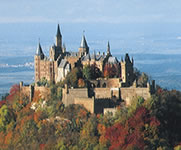Other highlights
Contact
Tourist Info + Service der Kur- und Kongress-GmbH
Louisenstrasse 58
61348 Bad Homburg v. d. Höhe
Email:
tourist-info@kuk.bad-hombur...
Internet:
www.bad-homburg.de
Louisenstrasse 58
61348 Bad Homburg v. d. Höhe
Email:
tourist-info@kuk.bad-hombur...
Internet:
www.bad-homburg.de
Places of interest

Designed in the style of an English landscape garden, the spa gardens in Bad Homburg were created around 150 years ago by the Director General of the Royal Prussian Gardens Peter Joseph Lenné, the finest landscape gardener of his time. Covering an area of 44 hectares, these are the largest spa gardens in Germany, and the Brunnenallee, a wide avenue lined with chestnut trees, lies at their heart. Along this avenue you can find the carbonated mineral springs, the historic Kaiser Wilhelm Spa, the casino and the Siamese Temple. Largely unaltered in its design and layout, this is the last of Lenné's parks that remains almost completely in its original format.
Bad Homburg's appeal as a health resort owes much to its unrivalled spa tradition. Ever since the end of the 19th century, people from all over the world have availed themselves of the beneficial and therapeutic treatments in the Kaiser Wilhelm Spa, the erstwhile royal spa. The enchanting location of the spa gardens augurs well for the revitalising range of spa treatments ahead. The lovingly detailed grandeur of the Kaiser Wilhelm Spa's architecture provides a setting that appeals to all the senses – expansive, high-ceilinged rooms, adorned with opulent tiled patterns and mosaics, radiate an atmosphere of luxurious bliss, while warm colours and exquisite fragrances provide balance and serve to complement the treatments.
The former residence of the Landgraves of Hessen-Homburg was built between 1680 and 1685 in place of a medieval castle. Its distinguishing feature, and Bad Homburg's landmark building, is the 14th century castle keep. Standing at 48 metres, this tower rises high above the two courtyards around which the baroque complex is clustered. In the rooms open to the public, art treasures from the 17th to the 19th century are on show. These serve to illustrate the domestic life of the Landgraves, as well as the Prussian Kings and German Kaisers who used Bad Homburg as a summer residence from 1866 to 1918. In the second half of the 18th century the palace gardens with their baroque buildings were transformed into landscaped gardens.
Travel Planner
Select an option...
Map of Germany
Hotels in Bad Homburg
Loading



